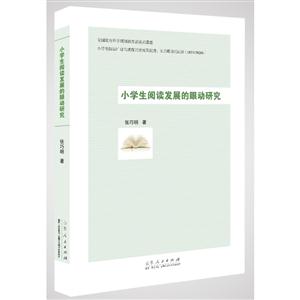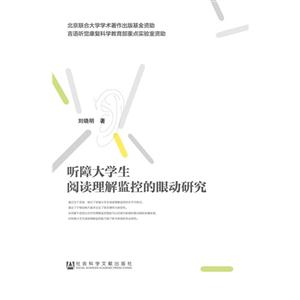
作者:李辉
页数:264
出版社:中国宇航出版社
出版日期:2023
ISBN:9787515922812
电子书格式:pdf/epub/txt
内容简介
《汉语动名四字词语搭配在句子阅读加工中的眼动研究》聚焦汉语动名四字词语搭配,采用眼动实验的方法,深入发掘汉语动名四字词语搭配在阅读中的加工机制。本书通过五个眼动实验,得出在阅读加工速度上,汉语词语搭配比非搭配速度更快;在影响因素上,语境预测性?搭配强度和联想强度影响阅读加工,其中搭配强度效应与语境预测性效应相互独立,而联想强度效应受语境预测性效应的影响?本书的研究结论可以为汉语搭配的深入研究,为汉语词语搭配习得和运用提供参考,为汉语阅读眼动模型发展提供数据支持?
作者简介
李辉,女,出生于1979年7月,浙大宁波理工学院外国语学院讲师,浙江大学外国语学院博士,研究领域为心理语言学,计量语言学。
本书特色
结构清晰、内容完整、实验丰富,为汉语搭配的深入研究,为汉语词语搭配习得和运用提供参考,为汉语阅读眼动模型发展提供数据支持
目录
Chapter 1 Introduction
1.1 Research background
1.2 Research objectives and questions
1.3 Research significance
1.4 Organization of the dissertation
Chapter 2 Literature Review
2.1 Working definition of collocations
2.2 Classification of collocations
2.3 Identification of collocations
2.4 Theoretical framework
2.4.1 Lexical priming theory
2.4.2 Usage-based theory and exemplar-based theory
2.4.3 Holistic processing theories
2.4.4 Analytic processing theory
2.4.5 Parallel processing theory
2.5 The processing of English collocation
2.5.1 The processing advantage of English collocation
2.5.2 Processing patterns of English collocation
2.5.3 Factors affecting the processing of English collocation
2.6 The processing of Chinese formulaic language
2.6.1 The processing of Chinese idioms
2.6.2 The processing of Chinese collocations
2.7 Conclusion
Chapter 3 Methodology
3.1 Introduction
3.2 Eye movements during reading
3.2.1 Background information of eye movements
3.2.2 Eye-tracking technology
3.2.3 Eye movement measures
3.2.4 Models of eye movement control during reading
3.2.5 Parafoveal processing during reading
3.3 Conclusion
Chapter 4 Study I: The Processing Advantages of Chinese Collocations
4.1 Introduction
4.2 Experiment 1: Comparison between Chinese collocations and non-collocations
4.2.1 Method
4.2.2 Results
4.2.3 Discussion
4.3 Conclusion
Chapter 5 Study II: Holistic or Analytic Processing
5.1 Introduction
5.2 Experiment 2: Manipulating the preview of the noun
5.2.1 Method
5.2.2 Results
5.2.3 Discussion
5.3 Experiment 3: Manipulating the preview of the last character
5.3.1 Method
5.3.2 Results
5.3.3 Discussion
5.4 Conclusion
1.1 Research background
1.2 Research objectives and questions
1.3 Research significance
1.4 Organization of the dissertation
Chapter 2 Literature Review
2.1 Working definition of collocations
2.2 Classification of collocations
2.3 Identification of collocations
2.4 Theoretical framework
2.4.1 Lexical priming theory
2.4.2 Usage-based theory and exemplar-based theory
2.4.3 Holistic processing theories
2.4.4 Analytic processing theory
2.4.5 Parallel processing theory
2.5 The processing of English collocation
2.5.1 The processing advantage of English collocation
2.5.2 Processing patterns of English collocation
2.5.3 Factors affecting the processing of English collocation
2.6 The processing of Chinese formulaic language
2.6.1 The processing of Chinese idioms
2.6.2 The processing of Chinese collocations
2.7 Conclusion
Chapter 3 Methodology
3.1 Introduction
3.2 Eye movements during reading
3.2.1 Background information of eye movements
3.2.2 Eye-tracking technology
3.2.3 Eye movement measures
3.2.4 Models of eye movement control during reading
3.2.5 Parafoveal processing during reading
3.3 Conclusion
Chapter 4 Study I: The Processing Advantages of Chinese Collocations
4.1 Introduction
4.2 Experiment 1: Comparison between Chinese collocations and non-collocations
4.2.1 Method
4.2.2 Results
4.2.3 Discussion
4.3 Conclusion
Chapter 5 Study II: Holistic or Analytic Processing
5.1 Introduction
5.2 Experiment 2: Manipulating the preview of the noun
5.2.1 Method
5.2.2 Results
5.2.3 Discussion
5.3 Experiment 3: Manipulating the preview of the last character
5.3.1 Method
5.3.2 Results
5.3.3 Discussion
5.4 Conclusion















